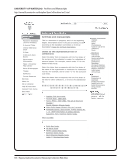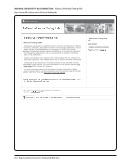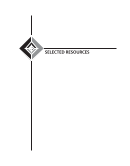SPEC Kit 307: Manuscript Collections on the Web · 17
standards and styles. Some institutions have dealt
with this problem through grant-funded initiatives.
In addition to the traditional lack of resource is-
sues libraries have always faced (not enough time
and staff to process collections), respondents also
report that technological problems are challenging
their efforts to get materials on the Web. Many of the
responses indicate that staff lack the technological
expertise to make the most of what a Web presence
has to offer, and they lack the technical support from
other departments within their institutions to make
it happen.
Another challenge is the added reference work
resulting from more access via the Web. One survey
answer explained, “As we put up more finding aids,
we are seeing increased use of the collections. Our
electronic reference service particularly reflects this
use. A challenge is to keep our reference service at a
level to meet this added demand, from both in person
and electronic researchers.”
Benefits
Certainly the most beneficial result of putting in-
formation about manuscript collections online is
increased access to collections. Not only does this
get the information out there, but it makes the col-
lections easier for researchers to use. Respondents
agree that another by-product of this increased access
is increased reference activities. Several comments,
however, indicate that patrons come to the reference
room armed with more information about collections,
i.e., box numbers, and therefore are easier to help.
Conclusion
The respondents are all managing to get at least some
information about their manuscript collections onto
the Web. Most of the comments indicated that they
want to get more there, but are unable to do so for a
variety of reasons. A select few have all their manu-
script collections represented on the Web in some
way, either as a MARC record, a brief blurb in HTML,
or an EAD finding aid.
Almost all respondents are creating MARC re-
cords for their collections fewer are creating EAD
finding aids. These simple statistics, however, are
deceptive because as one looks further one finds that
libraries aren’t necessarily creating large numbers of
finding aids in EAD, or any other format, or putting
information about large numbers of collections on the
Web. The overall numbers for creating MARC records
for collections are more impressive. Why is it easier
to create and use MARC records than to create and
use EAD? This has been explored by others, such as
Yakel and Kim, and the results of this survey appear
consistent with their findings. For various reasons
there is a range of attitudes and opinions relating to
the ease, usefulness, and value of EAD.
The survey discovered a lot of information about
who is doing the arrangement and description tasks
necessary before the information is published on
the Web. Librarians and archivists—those who are
trained and educated professionals—squeeze these
duties in between a multitude of other responsibili-
ties. They are not the only ones in these institutions
who perform arrangement and description tasks,
but they do spend larger percentages of their time
than anyone else in actually getting information on
the Web. Although 74% of respondents report they
have started to implement the “More Product, Less
Process” approach to arrangement and description as
suggested by Greene and Meissner, as a whole librar-
ies are still reporting large unprocessed backlogs. Not
surprisingly, 85% of the respondents report they only
consider a collection fully processed when there is a
finding aid with folder-level description.
The challenges in placing manuscript collection
information on the Web were not surprising. The
prevailing challenges relate to a lack of available re-
sources, as well as the technological abilities in get-
ting the information there. If libraries do not see an
increase in resources, then how will they manage to
get everything done? This lack of resources may not
ever change. What might change, however, is the un-
even level of technological ability and support across
institutions that allows some to place more informa-
tion on the Web than others. What does unite all of
us is our belief that access to our collections is critical,
and increased Web presence provides that access.
standards and styles. Some institutions have dealt
with this problem through grant-funded initiatives.
In addition to the traditional lack of resource is-
sues libraries have always faced (not enough time
and staff to process collections), respondents also
report that technological problems are challenging
their efforts to get materials on the Web. Many of the
responses indicate that staff lack the technological
expertise to make the most of what a Web presence
has to offer, and they lack the technical support from
other departments within their institutions to make
it happen.
Another challenge is the added reference work
resulting from more access via the Web. One survey
answer explained, “As we put up more finding aids,
we are seeing increased use of the collections. Our
electronic reference service particularly reflects this
use. A challenge is to keep our reference service at a
level to meet this added demand, from both in person
and electronic researchers.”
Benefits
Certainly the most beneficial result of putting in-
formation about manuscript collections online is
increased access to collections. Not only does this
get the information out there, but it makes the col-
lections easier for researchers to use. Respondents
agree that another by-product of this increased access
is increased reference activities. Several comments,
however, indicate that patrons come to the reference
room armed with more information about collections,
i.e., box numbers, and therefore are easier to help.
Conclusion
The respondents are all managing to get at least some
information about their manuscript collections onto
the Web. Most of the comments indicated that they
want to get more there, but are unable to do so for a
variety of reasons. A select few have all their manu-
script collections represented on the Web in some
way, either as a MARC record, a brief blurb in HTML,
or an EAD finding aid.
Almost all respondents are creating MARC re-
cords for their collections fewer are creating EAD
finding aids. These simple statistics, however, are
deceptive because as one looks further one finds that
libraries aren’t necessarily creating large numbers of
finding aids in EAD, or any other format, or putting
information about large numbers of collections on the
Web. The overall numbers for creating MARC records
for collections are more impressive. Why is it easier
to create and use MARC records than to create and
use EAD? This has been explored by others, such as
Yakel and Kim, and the results of this survey appear
consistent with their findings. For various reasons
there is a range of attitudes and opinions relating to
the ease, usefulness, and value of EAD.
The survey discovered a lot of information about
who is doing the arrangement and description tasks
necessary before the information is published on
the Web. Librarians and archivists—those who are
trained and educated professionals—squeeze these
duties in between a multitude of other responsibili-
ties. They are not the only ones in these institutions
who perform arrangement and description tasks,
but they do spend larger percentages of their time
than anyone else in actually getting information on
the Web. Although 74% of respondents report they
have started to implement the “More Product, Less
Process” approach to arrangement and description as
suggested by Greene and Meissner, as a whole librar-
ies are still reporting large unprocessed backlogs. Not
surprisingly, 85% of the respondents report they only
consider a collection fully processed when there is a
finding aid with folder-level description.
The challenges in placing manuscript collection
information on the Web were not surprising. The
prevailing challenges relate to a lack of available re-
sources, as well as the technological abilities in get-
ting the information there. If libraries do not see an
increase in resources, then how will they manage to
get everything done? This lack of resources may not
ever change. What might change, however, is the un-
even level of technological ability and support across
institutions that allows some to place more informa-
tion on the Web than others. What does unite all of
us is our belief that access to our collections is critical,
and increased Web presence provides that access.








































































































































































































